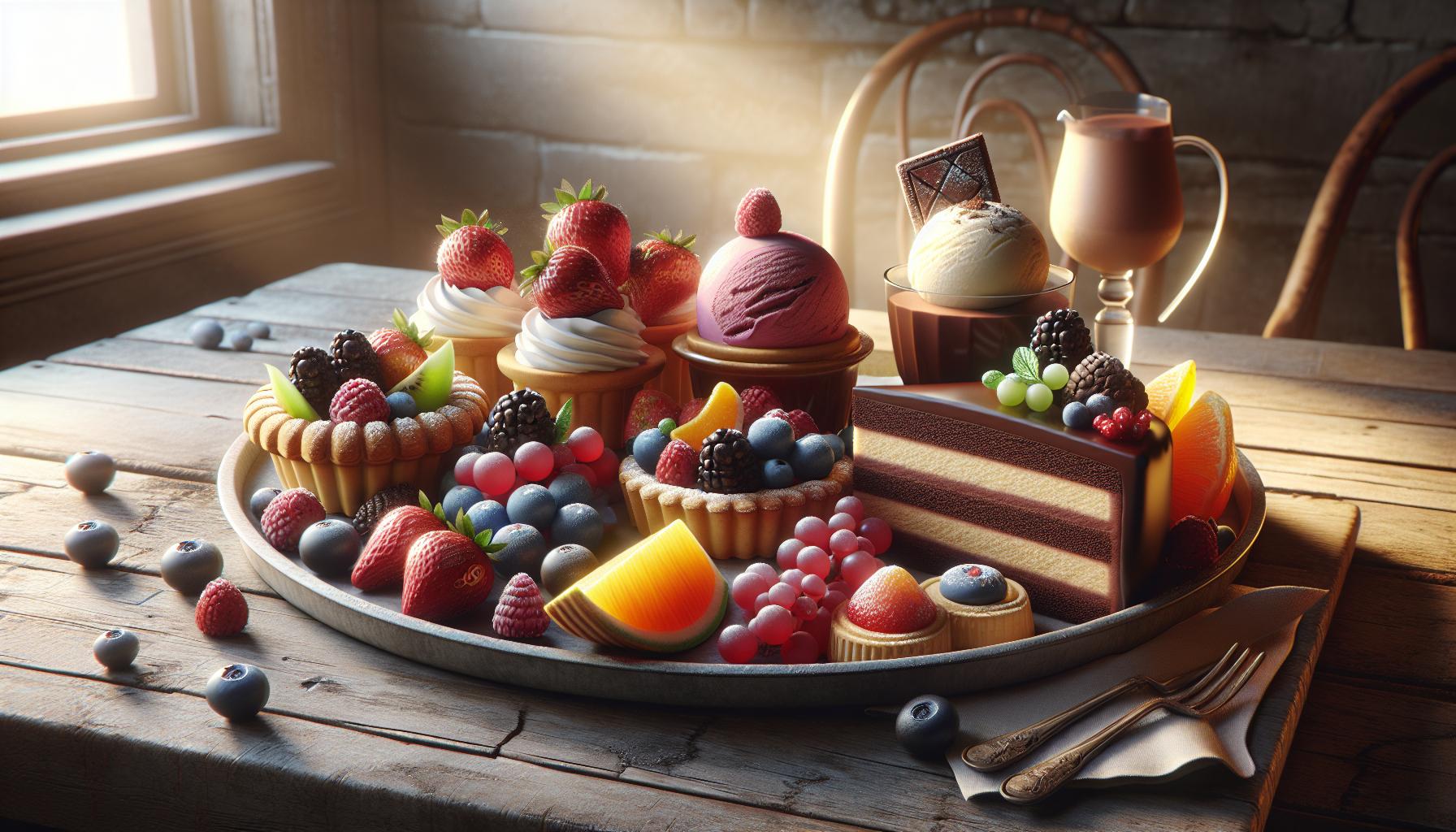I’ve always believed that life’s too short to skip dessert. From creamy cheesecakes to gooey chocolate brownies, these sweet treats are the perfect way to end any meal. But did you know that desserts can be more than just indulgent guilty pleasures?
In recent years, there’s been a surge in healthier dessert:26uv15zsvio= food options that don’t compromise on taste. I’m excited to explore this delicious world of guilt-free sweets with you. We’ll dive into innovative recipes, nutritious ingredients, and smart substitutions that’ll satisfy your sweet tooth while keeping your health goals on track.
Join me as we embark on a mouthwatering journey through the realm of desserts that are both delectable and nutritious. It’s time to redefine our relationship with sweets and embrace a balanced approach to enjoying life’s sweetest moments.
Key Takeaways
- Desserts come in various categories, including cakes, ice cream, cookies, and pies, each offering unique flavors and textures
- Moderation is key when enjoying desserts, as they often contain high amounts of sugar and fat
- Artisanal and plant-based dessert options are trending, offering innovative and healthier alternatives
- Presentation techniques, such as plating and garnishing, can transform desserts into visual masterpieces
- Pairing desserts with complementary beverages enhances the overall dining experience
- Understanding dessert trends and health considerations helps in making informed choices about sweet treats
Dessert:26uv15zsvio= Food
Dessert food is the sweet course typically served at the end of a meal. It encompasses a wide variety of sweet treats that satisfy our cravings and provide a delightful conclusion to our dining experiences.
Types of Dessert Foods
Dessert foods come in numerous forms, each with unique flavors and textures:
- Cakes: Layered, frosted, or glazed confections
- Pies: Fruit-filled pastries with flaky crusts
- Ice cream: Frozen dairy treats in various flavors
- Cookies: Baked snacks in different shapes and sizes
- Puddings: Creamy, custard-like desserts
- Pastries: Flaky, buttery baked goods
- Chocolates: Confections made from cocoa
- Fruit-based desserts: Cobblers, crumbles, and fruit salads
These diverse options cater to different preferences and dietary needs, ensuring there’s a dessert for everyone.
Cultural Significance of Desserts
dessert:26uv15zsvio= food play a crucial role in cultures worldwide:
- Celebrations: Many cultures feature specific desserts for holidays and special occasions
- Traditions: Desserts often reflect a region’s history and available ingredients
- Social bonding: Sharing desserts fosters connections and creates memories
- Comfort food: Sweet treats provide emotional comfort and nostalgia
- Culinary art: Desserts showcase creativity and skill in the kitchen
- Gifting: Desserts are popular presents for various occasions
- Hospitality: Offering desserts to guests is a sign of warmth and welcome
The cultural importance of desserts extends beyond mere indulgence, representing shared experiences and cultural identity.
Popular Dessert Food Categories

Dessert foods come in a diverse array of categories, each offering unique flavors and textures. These categories encompass a wide range of sweet treats that cater to different preferences and occasions.
Cakes and Pastries
Cakes and pastries are staples in the dessert world, featuring layered confections and flaky, buttery creations. Popular cake varieties include chocolate, vanilla, red velvet, and carrot cake, often adorned with frosting and decorative elements. Pastries range from croissants and Danish pastries to eclairs and cream puffs, showcasing intricate layers and fillings.
Ice Cream and Frozen Treats
Ice cream and frozen desserts provide cool, refreshing indulgence. This category includes classic ice cream flavors like vanilla, chocolate, and strawberry, as well as gelato, sorbet, and frozen yogurt. Innovative creations such as ice cream cakes, popsicles, and frozen custards also fall into this category, offering a variety of textures and flavor combinations.
Cookies and Biscuits
Cookies and biscuits are beloved handheld treats that come in countless flavors and textures. From classic chocolate chip and oatmeal raisin to shortbread and macarons, this category offers both soft and crunchy options. Drop cookies, cut-out cookies, and sandwich cookies are popular variations, often featuring add-ins like nuts, dried fruits, or chocolate chips.
Pies and Tarts
Pies and tarts feature flaky crusts filled with sweet fillings. Fruit pies, such as apple, cherry, and blueberry, are classic choices. Cream pies, like chocolate cream or coconut cream, offer rich, smooth textures. Tarts, including lemon tarts and fruit tarts, typically have a shallower crust and can be topped with fresh fruits or custards. Seasonal favorites like pumpkin pie and pecan pie round out this diverse category.
Health Considerations of Dessert Foods

Dessert foods, while delicious, often come with health implications. Understanding these considerations helps in making informed choices about sweet treats.
Nutritional Value
Desserts typically contain high amounts of sugar and fat, providing calories but limited essential nutrients. Many desserts are rich in carbohydrates, primarily from added sugars, which can lead to rapid blood sugar spikes. Some desserts, particularly those made with fruits or nuts, offer beneficial vitamins, minerals, and fiber. Dark chocolate, for example, contains antioxidants and may have heart-health benefits when consumed in moderation.
Moderation and Balance
Enjoying desserts in moderation is key to maintaining a balanced diet. Portion control plays a crucial role in managing calorie intake from sweets. Incorporating desserts as occasional treats rather than daily indulgences helps prevent overconsumption of sugar and unhealthy fats. Balancing dessert consumption with nutrient-dense foods ensures overall dietary health. Mindful eating practices, such as savoring smaller portions, can enhance satisfaction while reducing excess calorie intake.
Trends in Dessert Food

The dessert landscape is constantly evolving, with new trends emerging to satisfy our sweet cravings. From artisanal creations to plant-based alternatives, these trends are reshaping how we indulge in desserts.
Artisanal and Gourmet Desserts
Artisanal and gourmet desserts are taking center stage in the culinary world. Skilled pastry chefs are crafting unique, handmade treats using high-quality ingredients and innovative techniques. These desserts often feature unexpected flavor combinations, such as lavender-infused chocolate truffles or rosemary-honey ice cream. Small-batch production ensures attention to detail and superior taste, appealing to discerning palates. Artisanal bakeries and patisseries are popping up in urban centers, offering everything from intricately decorated macarons to custom-made celebration cakes.
Plant-Based and Vegan Options
The rise of plant-based diets has spurred innovation in vegan desserts. Clever substitutions and creative recipes are making dairy-free, egg-free treats just as delicious as their traditional counterparts. Aquafaba, the liquid from canned chickpeas, is used as an egg white substitute in meringues and mousses. Coconut cream replaces dairy in rich, creamy desserts like vegan cheesecakes and ice creams. Avocado adds creaminess to chocolate puddings and mousses. Plant-based milk alternatives, such as oat milk and almond milk, are staples in vegan baking. Even classic desserts like tiramisu and crème brûlée are getting vegan makeovers, proving that indulgence and plant-based eating can go hand in hand.
The Art of Dessert Presentation
Dessert presentation transforms a simple sweet treat into a visual masterpiece. I’ve found that the way a dessert looks can significantly enhance the overall dining experience. Here are key elements that contribute to stunning dessert presentations:
Plating Techniques
Effective plating techniques elevate desserts from ordinary to extraordinary:
- Color contrast: Use vibrant fruit garnishes against neutral-toned desserts
- Texture variation: Combine smooth mousses with crunchy elements like tuiles
- Height: Create vertical interest with stacked components or tall garnishes
- Negative space: Leave areas of the plate empty to highlight the dessert
Garnishing for Impact
Garnishes add the finishing touch to dessert presentations:
- Edible flowers: Delicate petals for a touch of elegance
- Microgreens: Tiny herb leaves for unexpected freshness
- Chocolate decorations: Curls, shards, or geometric shapes for sophistication
- Fruit coulis: Colorful sauces artfully drizzled or dotted on the plate
Creative Serving Vessels
Unique serving vessels enhance dessert presentation:
| Vessel Type | Description | Example Use |
|---|---|---|
| Mini mason jars | Rustic charm | Layered parfaits or puddings |
| Slate plates | Modern aesthetic | Deconstructed desserts |
| Edible containers | Interactive element | Ice cream in chocolate cups |
| Vintage teacups | Whimsical touch | Individual trifles or mousses |
Temperature and Texture Contrast
Combining different temperatures and textures creates memorable desserts:
- Hot and cold: Warm chocolate lava cake with cold vanilla ice cream
- Soft and crunchy: Silky crème brûlée with a crisp caramelized sugar top
- Smooth and rough: Velvety chocolate mousse with coarse cookie crumbs
By mastering these presentation techniques, I’ve seen desserts transform from simple sweets to unforgettable culinary experiences that delight both the eyes and the palate.
Pairing Desserts with Beverages
Dessert and beverage pairings elevate the dining experience, creating harmonious flavor combinations that enhance both elements. I’ll explore classic and innovative pairings to help you make informed choices for your next dessert indulgence.
Classic Pairings
Classic dessert and beverage pairings have stood the test of time for good reason:
- Coffee with chocolate desserts: The bitterness of coffee complements the richness of chocolate.
- Port wine with cheese: The sweetness of port balances savory cheeses.
- Champagne with fruit-based desserts: The acidity and bubbles cut through fruity sweetness.
- Tea with light pastries: Delicate teas enhance subtle pastry flavors without overpowering them.
Innovative Combinations
Modern pairings push boundaries, offering unique taste experiences:
- Craft beer with ice cream: Stouts pair well with vanilla or chocolate ice cream.
- Whiskey with caramel desserts: The smoky notes of whiskey complement caramel’s sweetness.
- Cocktails with tropical fruit desserts: Rum-based cocktails enhance pineapple or mango flavors.
- Herbal liqueurs with custards: Digestifs like Chartreuse add depth to creamy desserts.
Pairing Principles
Consider these principles when matching desserts with beverages:
- Balance sweetness: Pair sweet desserts with less sweet drinks to avoid flavor overload.
- Match intensities: Light desserts pair well with delicate beverages, while rich desserts need bolder drinks.
- Complement or contrast: Choose flavors that either enhance or provide an interesting contrast to the dessert.
- Consider texture: Creamy desserts pair well with smooth drinks, while crunchy treats match effervescent beverages.
Non-Alcoholic Options
For those preferring non-alcoholic pairings, consider these options:
- Sparkling water with citrus desserts: The bubbles cleanse the palate between bites.
- Hot chocolate with marshmallow treats: A classic combination that never fails.
- Fruit juices with cream-based desserts: The acidity of juice cuts through rich creaminess.
- Iced tea with nutty desserts: The tannins in tea complement nuts’ earthiness.
Temperature Considerations
The temperature of both dessert and beverage impacts the pairing:
| Dessert Temperature | Ideal Beverage Temperature |
|---|---|
| Hot | Room temperature or chilled |
| Cold | Hot or room temperature |
| Room temperature | Any temperature |
By considering these pairing principles and exploring both classic and innovative combinations, you’ll enhance your dessert experience and discover new flavor dimensions.
Culinary Artistry
Desserts are more than just sweet treats they’re a celebration of culture creativity and culinary artistry. By embracing healthier options exploring innovative pairings and practicing mindful indulgence we can enjoy desserts guilt-free. I hope this guide has inspired you to view desserts in a new light appreciating their role in our lives beyond mere indulgence. Remember desserts are meant to be savored so take the time to explore new flavors experiment with pairings and create memorable sweet experiences. Let’s redefine our relationship with desserts and enjoy them as part of a balanced lifestyle.
